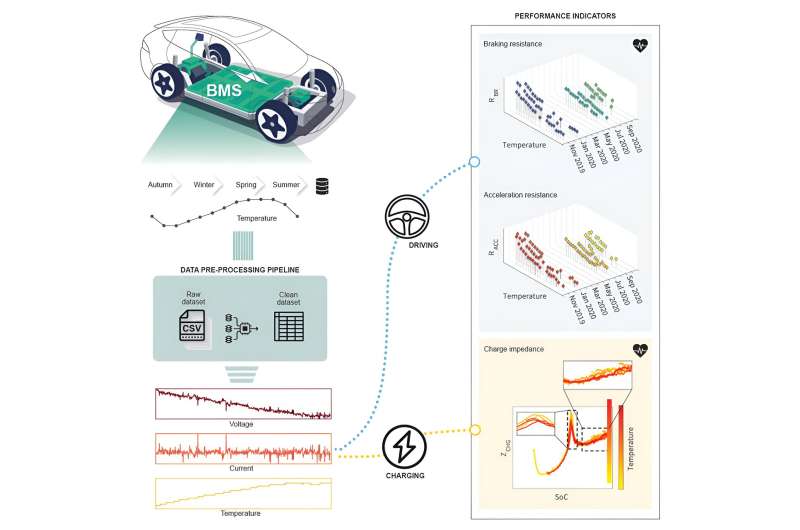This article has been reviewed according to Science X's editorial process and policies. Editors have highlighted the following attributes while ensuring the content's credibility:
fact-checked
peer-reviewed publication
trusted source
proofread
Improving EV batteries with real-world driving data

Most electric vehicles are equipped with an electronic brain that manages day-to-day battery performance and safety. This battery management system, or BMS, includes software that uses algorithms to monitor the overall health of the powerful lithium-ion battery pack.
"The algorithm tells you things like if your battery is doing OK, or how far you can drive before you need to recharge," said Simona Onori, an assistant professor of energy science and engineering in the Stanford Doerr School of Sustainability. "The problem is that BMS algorithms are designed in ideal laboratory conditions that do not reflect what a battery pack sees in the real world."
To demonstrate the gap between controlled laboratory testing and actual road experience, Onori and colleagues at Stanford collaborated with researchers at the Volkswagen Innovation and Engineering Center located near the university campus. Their results are published Aug. 18 in Joule.
"Algorithms based on unrealistic driving data are likely to be inaccurate in the field," said Onori, lead author of the study. "Our goal is to increase the longevity of the battery pack by designing algorithms trained from real-world data."
Driving styles
Battery management systems in electric cars on the road today routinely record data during braking, acceleration, deceleration, and charging.
"Real-world driving is driver specific," said study co-author Gabriele Pozzato, a Stanford research engineer. "You might be an aggressive driver, or someone who only partially charges their car. Different styles of driving and charging will result in different trajectories of battery degradation. However, that kind of field data is not included in conventional battery algorithms."
For the study, Volkswagen provided the Stanford team about 3,750 hours of BMS driving data collected from an all-electric Audi e-tron SUV driven in the San Francisco Bay Area for one year, from November 2019 to October 2020 (Audi is a subsidiary of Volkswagen).
Energy and power
Using the Audi field data, the Stanford team calculated the electrical resistance in the battery pack over the one-year period. These calculations enabled the team to assess two key battery metrics: energy and power.
"Energy gives you the range, or how many miles you can drive with a fully charged battery," Pozzato explained. "Power is the ability to extract energy quickly. When you accelerate, you want to get access to energy and discharge the battery very fast. The less electrical resistance you have in the battery, the more power you have."
To calculate resistance, the researchers measured abrupt changes in current and voltage in the battery pack using data from 529 acceleration events and 392 braking events during the year. They also calculated impedance—a measure of resistance during battery charging—by analyzing 53 charging sessions.
"Impedance and resistance are typically considered metrics of battery health," Onori said. "The more you drive, the more resistance increases. This usually translates into less available power from the battery pack, but that's not what we saw."
A more complex pattern emerged when the researchers added seasonal weather data to the mix. They discovered that electrical resistance decreased in cooler months and steadily increased in spring and summer, an indication that battery health improves as temperatures rise.
"Higher temperatures raise battery capacity, so you have this feeling that the car has more energy and that you can drive more miles," Onori said. "But if you keep using the battery at high temperatures, it will degrade faster. Those are very tricky factors that affect performance. Next year we'll expand our dataset to a fleet of vehicles to determine exactly how temperature and aging affect each other."
The lab vs. the road
Automakers rely on conventional BMS algorithms designed in pristine laboratory conditions. Using machine learning, these algorithms typically monitor performance data from a single 4-volt battery cell that continuously charges and discharges at a constant temperature until it dies. But the Audi field data was collected from a 396-volt battery pack powered by 384 cells.
"New algorithms should focus on the entire battery pack and not individual cells," Onori said. "We want to design algorithms that educate drivers on how to increase the life of the battery pack, which is the most expensive component of the vehicle. For example, you could alert drivers if they are fast-charging too much or accelerating too aggressively. So much can be learned from field data to make BMS algorithms more robust."
More information: Gabriele Pozzato et al, Analysis and key findings from real-world electric vehicle field data, Joule (2023). DOI: 10.1016/j.joule.2023.07.018
















